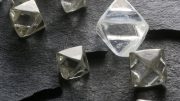The genesis of Canada’s diamond industry can be pinpointed precisely to twenty years ago this month. That’s when BHP Billiton reported that its partner Dia Met, had found diamonds in the Point Lake kimberlite, in the Lac de Gras area of the Northwest Territories.
What followed after that historic announcement is well documented in “The Point Lake ‘epiphany’”, written by Virginia Heffernan, who was a staff writer at The Northern Miner in the early 1990s, grappling with how to cover such a novel exploration story.
While the Point Lake kimberlite itself was never mined, the discovery led to Canada’s first diamond mine, Ekati, which opened in 1998, and recently produced its 50 millionth carat.
But what if Chuck Fipke and Stewart Blusson, the founders of Dia Met, had never made the discovery?
It’s a question not even Fipke himself, now chairman of Metalex Ventures, could answer when I caught up with him recently in Toronto.
“They say De Beers had been through the area, and didn’t pick it up, so I don’t know if somebody else would have gone through and looked for diamonds,” he says. “You have to realize that De Beers had been working in Canada for thirty, forty years and had not come up with anything, really, so for another company to do that without (De Beers) having found anything — I don’t know.”
Chad Ulansky, president and CEO of Metalex Ventures and Fipke’s business partner, suggests that if not for the Point Lake discovery, Canada’s diamond landscape might have an entirely different geography.
“De Beers had found Victor, although they didn’t realize that it was something significant at that point,” Ulansky says. “So, you could kind of imagine the diamond industry germinating from northern Ontario and gradually expanding out from there. Maybe this year, people would finally make it up to the Slave Craton, but it certainly would have been a very different history. Like Chuck says, I’m not sure that anybody would have started up in the Slave.”
But Dia Met did, and history was made.
Of all the wealth that Canada’s diamond mines have created, Fipke is most proud of the economic benefits they’ve had for First Nations communities. About 40% of employees at Ekati are First Nations.
“I think the diamond mines have substantially contributed to the health of the whole country,” he says. “It’s been a good thing.”
At the time, the discovery was “kind of amazing,” even to Fipke, given the skepticism around Canada’s diamond potential.
“Most geologists believed that diamonds were only found in South Africa and Russia and there would never be a Canadian diamond mine,” he notes.
Indeed, it wasn’t an easy road for Fipke, his partner Blusson, or Hugo Dummett, the geologist who convinced BHP to partner with Dia Met — at the time, a cash-poor junior with an outlandish vision.
For Fipke, who managed his own lab and ran Dia Met’s field programs, it meant routinely working 14-hour-plus days, six-and-a-half days a week.
“Only on Sunday afternoons did I take my kids out horseback riding,” he says. “For three years, we never took a holiday.”
The technology and know-how related to diamond exploration is no longer the closely guarded secret it once was. But while Fipke believes there are more mines to discover in Canada, it won’t get easier to find them, judging by his own experience in South Africa — the birthplace of the diamond industry.
“We did a little (sortie) into South Africa and we found ten projects that we invested in and worked at,” he says. “All ten of them failed, hey. It becomes harder once the ground’s been gone over, it becomes harder to find mines.”
Hard work alone may not find the next generation of diamond mines in Canada, but the ingenuity and resourceful spirit that pervade our industry will.



Be the first to comment on "The birth of an industry"